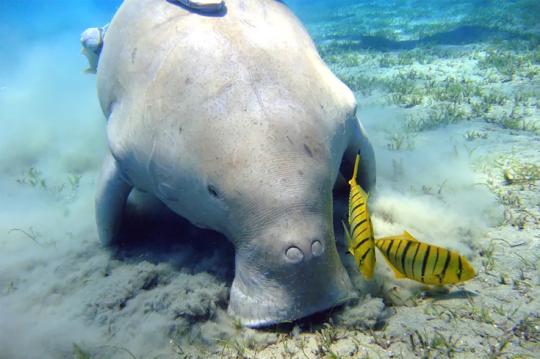The dugong is a marine mammal related to the manatee. Dugongs and manatees are members of the order Sirenia, which in turn is included in a larger group called Afrotheria. Also included in Afrotheria are elephants, hyraxes, aardvarks, elephant shrews, golden moles, and tenrecs. The dugong feeds on seagrasses and other shallow vegetation found within 1-5 meters of water in the Indian Ocean and the western Pacific. It is a docile animal, like land-based grazing mammals such as cows and sheep.
A single baby is born underwater and surfaces immediately to get its first breath. A baby will ride on its mother’s back as she submerges to feed and rises to the surface to breathe when she does. Observation shows that dugongs come to the surface about every three minutes. A female may produce milk for her young for up to 18 months, but babies begin to eat vegetation by three months of age.

Dugongs have numerous adaptions to marine life, including the modification of its front limbs as flippers and the complete loss of hind limbs. Unlike the manatee’s paddle-like tail, a dugong’s tail looks like that of a dolphin. The lungs are elongated as are the kidneys, which are important to helping the animal cope with living in seawater. Observation of wild populations indicates that dugongs may live up to 70 years. However, a female only gives birth every 3–7 years, so premature deaths can have a significant impact on the stability of the population.
Sharks are the dugong’s main natural enemy although large groups of dugongs occasionally have been observed driving a shark away after an attempted attack. However, dugongs are more often found alone, in pairs or in small groups. Killer whales have also been observed feeding on dugong. For many years, the dugong was hunted as a source of leather, meat, and oil. Now, humans pose the largest threat due to loss of seagrass habitat and the impact of fishing where dugong become caught in nets and cannot surface to breathe.
Coastal populations from the Red Sea south to Madagascar, and east to India and Southeast Asia have fallen dramatically in recent decades. Now, the largest populations, by far, are in the waters surrounding Australia where most research on this species takes place. Many countries have passed laws protecting the dugong, but various body parts are used in traditional medicine, making poaching problematic and protection especially difficult because of the ocean environment. Many different cultures assign a variety of special powers to the dugong. Fascination with dugongs can be found throughout time, from a 5,000-year old cave drawing found in Malaysia to inclusion in Cabinets of Curiosity beginning in the Renaissance. The dugong is thought to be the inspiration of the mythological mermaid, hence the name Sirenia for its order. In fact, the name dugong is from the Malay word for “lady of the sea.”
Sue McLaren is the Collection Manager in the Section of Mammals and Chair of Collections for Carnegie Museum of Natural History. She lives on the Northside with her husband Andy. Museum employees are encouraged to share their unique experiences from working at the museum.
